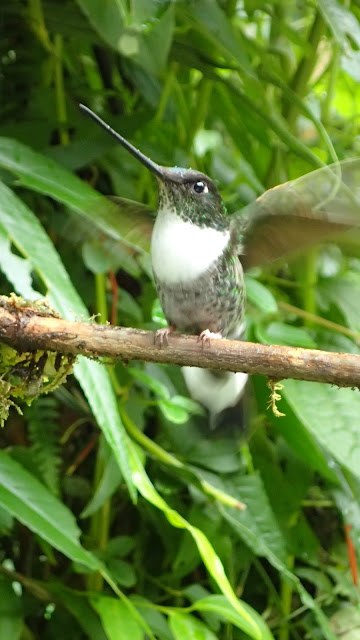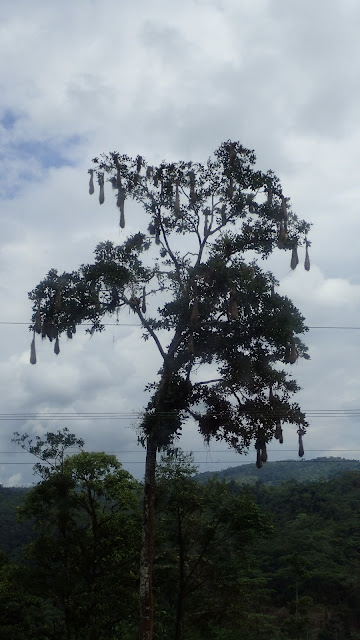The grounds of the hummingbird sanctuary were incredible. Offering the hummingbirds so many varieties of flowers to choose from, and a supplement of home-made nectar in feeders. I really wish I had brought a better camera for this part of the trip, but quite honestly I was afraid of the rain. If anyone else got better pictures of the hummingbirds, I will happily replace my pictures with theirs.
Not only were there hundreds of types of hummingbirds, but there was just so much to look at everywhere we turned. It was amazing!
The lodge at the sanctuary had a nice dining room with coffee and coca tea available. It was a great place to take a little break before heading back out into the hummingbird paradise.
In North America we don't have nearly as many varieties of hummingbirds as they have in South America. It was mind-blowing to see so many different kinds in one place.
Look how long the beak is on this one.
They had some little cabins at the sanctuary that were so cute, and I would imagine that if you stayed in them you would have all of your meals provided at the lodge. I told Steve that I could spend about a month here, just enjoying the beauty of the hummingbirds and the tranquility of this amazing place. It's not that big, but there is just so much to see if you look closely.
These are a variety of orchid. Amazing!
Many thanks to our beautiful daughter who sent me a few of her pictures to supplement what I had!
And as we continued on to the Amazon Valley, the views didn't disappoint me, even through a rainy bus window.
This is a driveway leading up to a little house on the hill.
One of our snack and potty break stops on the way.
We found some fabulous snacks at the store. Corn Nuts on steroids, only better!
And chicken flavored potatoe chips. Yum! I didn't think I'd like these, but they were really good.

The family pet hiding from the rain.
These are the nests of the Montezuma Oropendola birds hanging in the tree. Most of the trees didn't have any, but if we saw one nest, we saw many. These birds live in communities and help each other with the work.

This is the river we will live on for the next few days. It is a tributary to the Amazon in the Amazon rain forest valley.
There are 16 million people in Ecuador and 30% of them are indigenous people living in communities like this throughout the rain forest. Many of these people still live without modern conveniences, living off of what the land provides.
It is now a requirement for kids to go to elementary school, but many of these kids have to travel a long way (often by river) each day just to attend. Most of the indigenous people live near the rivers, which are their highways to the world. Although Castilian Spanish is the official language of Ecuador, the indigenous people still speak their own language known as Quechua.
We drove through a small Quechua community on our way to catch our next transportation to the hotel.
Our adventure will continue in the next post as we catch our canoes that will take us to our hotel.

































































No comments:
Post a Comment